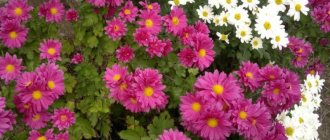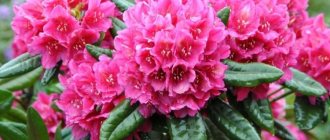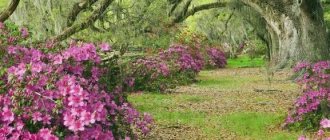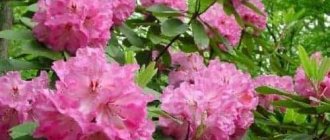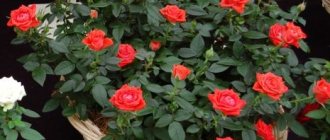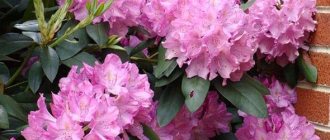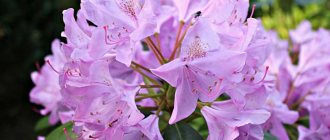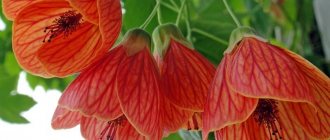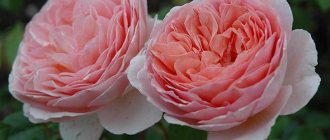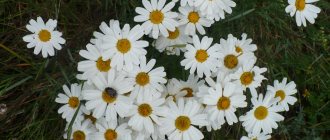Rhododendron is a beautifully flowering shrub native to the warm subtropics of Southeast Asia. Shrubs with a wide range of shades quickly became popular among gardeners and decorators. But the exotic beauty refused to spend the winter in frosty and cold conditions. Thanks to the hard work of breeders, many hybrid species of rhododendron have been developed. They are already frost-resistant and can withstand the harsh weather conditions of late autumn.
Deciduous rhododendrons are low shrubs (1-1.5 m) that are capable of densely covering the entire crown with bunches of flowers. Flowers of all shades (except pure blue) are bell-shaped, large, and can be decorated with colored spots, inclusions, and wavy edges. During flowering, the shrub complements its beauty with a pleasant aroma.
During flowering, this exotic has no equal
Where to plant deciduous rhododendron
Rhododendron katevbinskiy Grandiflorum
When choosing a location for shrubs to grow, you should consider:
- Rhododendron does not like sunny open areas. The area should be partially shaded. It is possible that the bush is illuminated for half of the day and is in the shade for the rest of the day. In winter, there should also be shade to avoid diaper rash on the branches and root collar.
- It is important to protect the bush from the wind, but fresh air flow is necessary for full growth.
- The bush will quickly die in a place where water stagnation will periodically form. Breeders recommend planting the bushes slightly on a hill so that water does not linger at the roots during rains and melting snow.
Aristocrat of the flower kingdom
In the wild, shrubs and subshrubs of rhododendron are no less decorative than garden forms of the crop. It forms picturesque thickets on mountain slopes, reaches the alpine belt, grows in the undergrowth, and prefers moisture-absorbing soils in open spaces. Representatives of this extensive genus of the Heather family are distinguished by their diversity - there is a vigorous shrub up to 30 m high, more like a tree, but there are also creeping varieties of dwarf sizes.
Garden rhododendron develops slowly in the first years of the growing season, in adult form it forms a bush or tree with annual or perennial foliage of various shapes and textures - there are leaves dense and smooth, with a velvety leaf plate, large and small, whole-cut and carved, dark malachite and variegated . The flowers of cultivated varieties of rhododendron are large, collected in dense racemes or inflorescences.
Japan was the first to introduce these exquisite plants into culture. But the flower and ornamental shrub received mass recognition after its migration to Europe. More than 300 years ago, it appeared in English gardens and ideally took root in a mild, humid climate. It was from here that his triumphant march around the world began.
The Russian climate is not exactly what moisture-loving and heat-loving plants need, but among rhododendrons there are many frost-resistant varieties. These include the Katevba, Canadian, Japanese, Daurian, Schlippenbach, Caucasian and others.
Transfer rules
The reason for the unsatisfactory condition of the shrub may be an incorrectly chosen location. This situation can be corrected by moving the deciduous rhododendron, especially since this procedure promotes the growth of young shoots and the formation of lush inflorescences. The favorable period for transplantation is considered to be early spring or late autumn. It is not recommended to carry out this activity while the bush is flowering. For the purpose of replanting, the bush should be carefully dug up.
Also read about how to deal with pests and diseases of rhododendrons.
In this case, it is necessary to take into account the superficial distribution of the root system mainly in width rather than in depth. The shrub is removed simultaneously with the earthen lump and moved into a pre-prepared hole. The new landing site should be characterized by an orientation corresponding to the cardinal directions, which was at the previous site. After moving, the bush should be watered abundantly and shade should be provided for several days.
Diseases and pests
Comfortable living conditions prevent the shrubs from getting sick; they are rarely susceptible to pest attacks.
- Diseases are most often fungal in nature. For prevention, every spring the bush is treated with copper sulfate.
- The shoots should be periodically inspected for pests. Among them you can find spider mites, bedbugs, and mealyworms. If pests are detected, the bushes are treated with special means (diluted according to the description of the drug).
Deciduous varieties are excellent as the first rhododendron shrub in the garden. They are more hardy and winter-hardy. This beautiful exotic plant decorates the garden with riotous colors in the spring, in the summer it is a wonderful landscaping of the garden, and in the fall the riot of colors on the foliage makes you once again admire the beauty of the deciduous rhododendron.
How to identify a deciduous variety
Rhododendron yellow: deciduous, azalea pontica
One of the differences from evergreen varieties is more abundant flowering. Deciduous varieties have more peduncle branches than semi-deciduous or evergreen varieties. Another difference is the riot of autumn colors on the leaves of deciduous varieties.
Autumn colors are in full bloom on deciduous varieties
With the arrival of autumn, the leaves change color from fiery yellow to crimson red. The decorative properties of the bush from spring to late autumn remain at their best. These exotics do not grow too quickly and lend themselves very well to pruning and decorative crown formation. The frost resistance of the bush also influences the choice towards deciduous.
Attention! Residents of Siberia and similarly harsh climatic zones should think about covering rhododendron for the winter.
Deciduous varieties are less picky about maintenance conditions and are more hardy, so they are suitable for beginner gardeners and future rhododendron lovers.
What are the features of preparing for winter in different regions?
The main nuances of protecting these plants in winter and early spring are protecting shoots and evergreen varieties from the sun's rays, which can cause burns on wood and foliage. To prevent this from happening, in the middle zone (in the Moscow region), in the Volga region, in the Urals and in Siberia, in the third ten days of February - the first ten days of March, it is necessary to shade the bushes from the south and west.
In these regions, the following varieties are less susceptible to burning in early spring:
- dwarf;
- Vazeya;
- Canadian;
- Ledebura;
- Pink;
- Adhesive.
And large-leaved evergreen rhododendrons tolerate bright spring sunlight less well.
Features of caring for rhododendron in the fall and preparing for winter
Many gardeners believe that flowering shrubs only require care during the summer while they continue to bloom. And when the flowers have fallen, you can do nothing further - the bushes do not need further care. But this is not so, and this flower is no exception. The growth and abundant flowering of this perennial in the next season depends on how the rhododendron is prepared for winter.
And in the fall, you need to take especially careful care of young plants that were planted this season. Moreover, you need to know what varieties of rhododendrons were planted.
Although most of these perennials are quite pampered plants, recently breeders have developed varieties with high frost resistance that can withstand cold temperatures down to -35 C and below.
These bushes are evergreen perennials, so their foliage evaporates moisture during the winter. Therefore, they do not stop watering rhododendron not only in autumn, but also in winter.
Planting in open ground
Planting and further caring for deciduous rhododendron will ensure high-quality growth and flowering. Before planting in open ground, it is important to prepare the soil, seedling and future hole for planting:
- The soil needs to be slightly acidic. A mixture of peat, sand, leaf soil and pine humus is an excellent composition for the healthy growth of seedlings. Before planting, the mixture is moistened and enriched with mineral fertilizers.
- A seedling purchased in a pot acquired a layer of dead roots along the perimeter of the pot during its growth. Dry roots must be removed, but the native soil will only help to grow and adapt to new conditions.
- The hole for planting is 50 cm deep and 80 cm wide and must have a layer of broken brick or expanded clay 15 cm thick. After rooting, it is important to leave the root nodule above the surface of the ground.
To preserve moisture and nutrients, the soil around the shoot needs to be mulched with pine needles or peat.
A layer of mulch around the flower
Medicinal properties
Flower tea helps with colds
Rhododendron contains large quantities of ascorbic acid, tannins, essential oils, phytoncides, rutin, tannins, arbutin, andromedotoxin, ericoline, and many other elements that make it one of the medicinal plants.
Caucasian, golden, Daurian, and Indian rhododendron have pronounced medicinal properties.
Preparations prepared from the leaves and flowers of the plant give the following effect:
1bactericidal
2painkiller
3calming
4antipyretic
5sweatshop
- Bactericidal properties are used in the fight against staphylococci, streptococci, and pathogenic microorganisms.
- A decoction of flowers helps in the treatment of diseases of the gastrointestinal tract. It is part of a diuretic drug for urolithiasis.
- Rubbing a tincture of leaves and flowers into sore spots helps with polyarthritis, osteochondrosis, neuralgia, and sciatica. The ability to remove fluid from the body is used in many diseases, as it helps to cope with swelling, which contributes to improved health. Used to treat diseases of the heart and blood vessels, hypertension.
- Preparations from the leaves alleviate the condition of bronchial asthma, epilepsy, soften dry cough, have a beneficial effect on the lungs, and relieve fever. The calming effect improves sleep, relieves irritability and nervousness.
- An infusion of leaves is used as a douche for uterine erosion.
- Flower tea relieves pain in the head and throat. Effective for colds.
- An alcohol tincture of flowers and leaves is taken for mercury vapor poisoning and inflammation of the mucous membrane.
Since rhododendron contains a small amount of toxic elements, preparations made from it are contraindicated:
- Nursing mothers
- Pregnant women
- Patients with acute renal failure
The content of a large amount of essential oils makes rhododendron popular in the perfume industry. Extracts from the plant are used to make perfume.
Subtleties of care
Active growth and flowering will be influenced by the following factors:
- Feeding. Mineral or organic complementary foods, once every three weeks from spring to autumn.
- Periodically renew the mulch layer and remove weeds. Loosening the soil must be approached as carefully as possible, since the roots of rhododendron are superficial and very fragile.
- After flowering, it is important to remove all dried flowers to stimulate the formation of flowering buds for the next year.
- Spring and autumn pruning are equally important and have different character. In spring, the plant is prepared for flowering by stimulating the active growth of branches. All damaged branches are also removed during the wintering period. Autumn pruning prepares the bush for sleep. Here too long shoots are removed and the crown of the bush is formed.
Grandmother
The plant is very cute, just like its “name”. Species: Japanese azalea. A low bush can be great when creating a border or hedge.
This azalea will appeal to those who love voluminous inflorescences. No one can resist such bright pinkish flowers.
Grandmother
general description
Rhododendron is an evergreen shrub of the heather family. There is a wide variety, numbering up to 3000 species. Among them there are both creeping shrubs and trees reaching thirty meters in height.
There are deciduous varieties. Translated from Latin, rhododendron means tree of roses.
Rhododendron is represented by a wide variety of species
Indeed, the flowers, formed in lush clusters, resemble pink flowers, which vary in size and shape depending on the variety. The smallest ones are a few millimeters in diameter, and the largest ones reach 20 cm.
Cultivated for its beautiful flowers of varied colors:
- purple
- red
- yellow
- orange
- pink
- raspberry
- white
- The shape of flowers is varied, there are: funnel-shaped, tubular, bell-shaped, wheel-shaped. The flowers produce a fruit, which is a five-leaf capsule filled with seeds up to 2 mm.
- Decorative egg-shaped leaves form an elegant crown. There are specimens with deep-set leaves and petioles. The roots have a surface system of many thin layers, which greatly facilitates replanting the plant.
They grow wild in coastal areas of seas, rivers, and on the northern slopes of the mountains of Southeast Asia.
